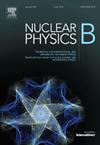我们能确定核子的确切大小吗?:对不同半径的综合研究
IF 2.5
3区 物理与天体物理
Q2 PHYSICS, PARTICLES & FIELDS
引用次数: 0
摘要
核子半径的概念在我们理解质子和中子的内部结构中起着核心作用,为量子色动力学(QCD)的非摄动制度提供了关键的见解。虽然电荷半径通常被解释为核子的“大小”,但这种解释过于简化,忽略了核子结构的多面性。本文全面概述了不同的核子半径,包括电荷半径和磁半径,轴向半径,以及新兴的机械半径和质量半径的概念。我们讨论了这些半径的定义以及实验、理论和现象学的决定,突出了它们独特的物理起源和含义。通过综合最近的实验结果和理论进展,我们强调每个半径反映了核子内部结构的一个特定方面,例如其电荷分布,磁性,弱相互作用或内部机械应力。特别是,我们解决了质子半径作为其大小的简单度量的常见但误导性的解释,强调了核子半径的细微差别和上下文依赖性质。通过这一探索,我们的目的是澄清这些半径在表征核子结构中的作用,并确定仍有待解决的开放性问题。这项工作有助于更深入地了解核子及其在粒子和核物理学更广泛背景下的意义。本文章由计算机程序翻译,如有差异,请以英文原文为准。
Can we determine the exact size of the nucleon?: A comprehensive study of different radii
The concept of nucleon radii plays a central role in our understanding of the internal structure of protons and neutrons, providing critical insights into the non-perturbative regime of quantum chromodynamics (QCD). While the charge radius is often interpreted as the “size” of the nucleon, this interpretation is an oversimplification that overlooks the multifaceted nature of nucleon structure. This paper provides a comprehensive overview of the different nucleon radii, including the charge and magnetic radii, the axial radius, and the emerging concepts of mechanical and mass radii. We discuss the definitions as well as the experimental, theoretical and phenomenological determinations of these radii, highlighting their distinct physical origins and implications. By synthesizing recent experimental results and theoretical advancements, we emphasize that each radius reflects a specific aspect of the nucleon's internal structure, such as its electric charge distribution, magnetic properties, weak interactions, or internal mechanical stress. In particular, we address the common but misleading interpretation of the proton radius as a simple measure of its size, underscoring the nuanced and context-dependent nature of nucleon radii. Through this exploration, we aim to clarify the roles of these radii in characterizing nucleon structure and to identify open questions that remain to be addressed. This work contributes to a deeper understanding of the nucleon and its significance in the broader context of particle and nuclear physics.
求助全文
通过发布文献求助,成功后即可免费获取论文全文。
去求助
来源期刊

Nuclear Physics B
物理-物理:粒子与场物理
CiteScore
5.50
自引率
7.10%
发文量
302
审稿时长
1 months
期刊介绍:
Nuclear Physics B focuses on the domain of high energy physics, quantum field theory, statistical systems, and mathematical physics, and includes four main sections: high energy physics - phenomenology, high energy physics - theory, high energy physics - experiment, and quantum field theory, statistical systems, and mathematical physics. The emphasis is on original research papers (Frontiers Articles or Full Length Articles), but Review Articles are also welcome.
 求助内容:
求助内容: 应助结果提醒方式:
应助结果提醒方式:


